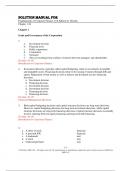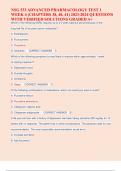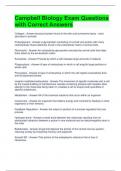1-1 © McGraw Hill LLC. All rights reserved. No reproduction or distribution without the prior written consent of McGraw Hill LLC. Solution Manual for Fundamentals of Corporate Finance 11th Edition by Brealey Chapter 1-24 Chapter 1 Goals and Governance of the Corporation 1. a. Investment decision b. Financial asset c. Public corporation d. Corporation e. Treasurer f. The cost resulting from conflicts of interest between managers and shareholders Est time: 01 –05 Introduction to Corporate Finance 2. Investment decisions, typically called capital budgeting, relate to investments in tangible and intangible assets. Financing decisions relate to the raising of money through debt and equit y. Repayment of that money as well as interest and dividends are also financing decisions. a. Investment decision b. Financing decision c. Investment decision d. Investment decision e. Financing decision f. Financing decision : Est time: 01 –05 Financial Management Decisions 3. Both capital budgeting decisions and capital structure decisions are long -term decisions. However, capital budgeting decisions are long -term investment decisions, while capital structure decisions are long -term financing decisions. Capital structure deci sions essentially involve selecting between equity financing and long -term debt financing. Est time: 01 –05 Introduction to Corporate Finance 4. a. A share of stock financial b. A personal IOU financial c. A trademark real d. A truck real e. Undeveloped land real 1-2 © McGraw Hill LLC. All rights reserved. No reproduction or distribution without the prior written consent of McGraw Hill LLC. f. The balance in the firm’s checking account financial g. An experienced and hardworking sales force real h. A bank loan agreement financial Est time: 01 –05 Introduction to Corporate Finance 5. ―Companies usually buy real assets. These include bot h tangible assets such as executive airplanes and intangible assets such as brand names . To pay for these assets, they sell financial assets such as bonds . The decision about which assets to buy is usually termed the capital budgeting or investment decision. The decision about how to raise the money is usually termed the financing decision.‖ Est time: 01 –05 Financial Management Decisions 6. a. Private corporation b. Partnership c. Public corporation d. Public corporation Est time: 01 –05 Forms of Business Organization 7. Double taxation means that a corporation’s income is taxed first at the corporate tax rate. When the income is distributed to shareholders as dividends, the income is taxed again at each shareholder’s personal tax rate. Est time: 01 –05 Forms o f Business Organization 8. C. Ownership can be transferred without affecting operations and D. Managers can be fired with no effect on ownership . Est time: 01 –05 Forms of Business Organization 9. The individual stockholders of a corporation (i.e., the owners) are legally distinct from the corporation itself, which is a separate legal entity. Consequently, the stockholders are not personally liable for the debts of the corporation; the stockholders’ liability for the debts of the corporation is limited to the in vestment each stockholder has made in the shares of the corporation. Est time: 01 –05 Forms of Business Organization 10. B. The corporation survives even if managers are dismissed and C. Shareholders can sell their holdings without disrupting the business. Est time: 01 –05 Forms of Business Organization 1-3 © McGraw Hill LLC. All rights reserved. No reproduction or distribution without the prior written consent of McGraw Hill LLC. 11. Limited liability is generally advantageous to large corporations. Large corporations would not be able to obtain financing from thousands or even millions of shareholders if those shareholders were not protecte d by the fact that the corporation is a distinct legal entity, conferring the benefit of limited liability on its shareholders. On the other hand, lenders do not view limited liability as advantageous to them. In some situations, lenders are not willing to lend to a corporation without personal guarantees from shareholders, promising repayment of a loan in the event that the corporation does not have the financial resources to repay the loan. Typically, these situations involve small corporations, with only a few shareholders; often these corporations can obtain debt financing only if the shareholders provide these personal guarantees. Est time: 01 –05 Forms of Business Organization 12. B. Responsible for investing the firm’s spare cash and C. Responsible for arranging any issue of common stock. Est time: 01 –05 Management Organization and Roles 13. The responsibilities of the treasurer include the following: supervising cash management, raising capital, and banking relationships. The controller’s responsibilities include supervision of accounting, preparation of financial statements, and tax matters. The CFO of a large corporation supervises both the treasurer and the controller. The CFO is responsible for large -scale corporate planning and financial policy. Est ti me: 01 –05 Management Organization and Roles 14. Answers will vary. For example, a corporation might cut its labor force dramatically, which could reduce immediate expenses and increase profits in the short term. Over the long term, however, the firm might not be able to serve its customers properly, or it might alienate its remaining workers; if so, future profits will decrease, the stock price, and the market value of the firm, will decrease in anticipation of these problems. Similarly, a corporation can boo st profits over the short term by using less costly materials even if this reduces the quality of the product. Once customers catch on, sales will decrease and profits will fall in the future. The stock price will fall. The moral of these examples is that , because stock prices reflect present and future profitability, the corporation should not necessarily sacrifice future prospects for short -
term gains. Est time: 01 –05 Goal of Financial Management 15. Financial managers refer to the opportunity cost of capit al because corporations increase value for their shareholders only by accepting all investment projects that earn more than this rate. If the company earns below this rate, the market value of the company’s stock falls and stockholders look for other place s to invest. 1-4 © McGraw Hill LLC. All rights reserved. No reproduction or distribution without the prior written consent of McGraw Hill LLC. To find the opportunity cost of capital for a safe investment, managers and investors look at current interest rates on safe debt securities, such as U.S. Treasury debt. Est time: 01 –05 Cost of Capital —General 16. The stock price reflects the value of both current and future dividends that the shareholders expect to receive. In contrast, profits reflect performance in the current year only. Profit maximizers may try to improve this year’s profits at the expense of future profits. But stock -price maximizers will take account of the entire stream of cash flows that the firm can generate. They are more apt to be forward -looking. Est time: 01 –05 Goal of Financial Management 17. In this situation, a ―superior‖ rate of return is a rate greater than the rate of return investors could earn elsewhere in the financial markets from alternative investments with risk equal to that of the ― high-risk capital investment‖ described in the problem. Fritz (who is risk -averse) will likely sell the investment since he is risk averse. Frieda (who is risk -tolerant) will likely keep her shares since it matches her risk tolerance. Est time: 01 –05 Goal of Financial Management 18. a. This action might appear, superficially, to be a grant to former employees and thus not consisten t with value maximization. However, such ―benevolent‖ actions might enhance the firm’s reputation as a good place to work, might result in greater loyalty on the part of current employees, and might contribute to the firm’s recruiting efforts. Therefore, f rom a broader perspective, the action may be value -maximizing. b. The reduction in dividends, in order to allow increased reinvestment, can be consistent with maximization of current market value. If the firm has attractive investment opportunities, and want s to save the expenses associated with issuing new shares to the public, then it could make sense to reduce the dividend in order to free up capital for the additional investments. c. The corporate jet would have to generate benefits in excess of its costs i n order to be considered stock -price enhancing. Such benefits might include time savings for executives and greater convenience and flexibility in travel. d. Although the drilling appears to be a bad bet, with a low probability of success, the project may be value -maximizing if a successful outcome (although unlikely) is potentially sufficiently profitable. A one -in-five chance of success is acceptable if the payoff conditional on finding an oil field is 10 times the costs of exploration. Est time: 06 –10 Goal of Financial Management






